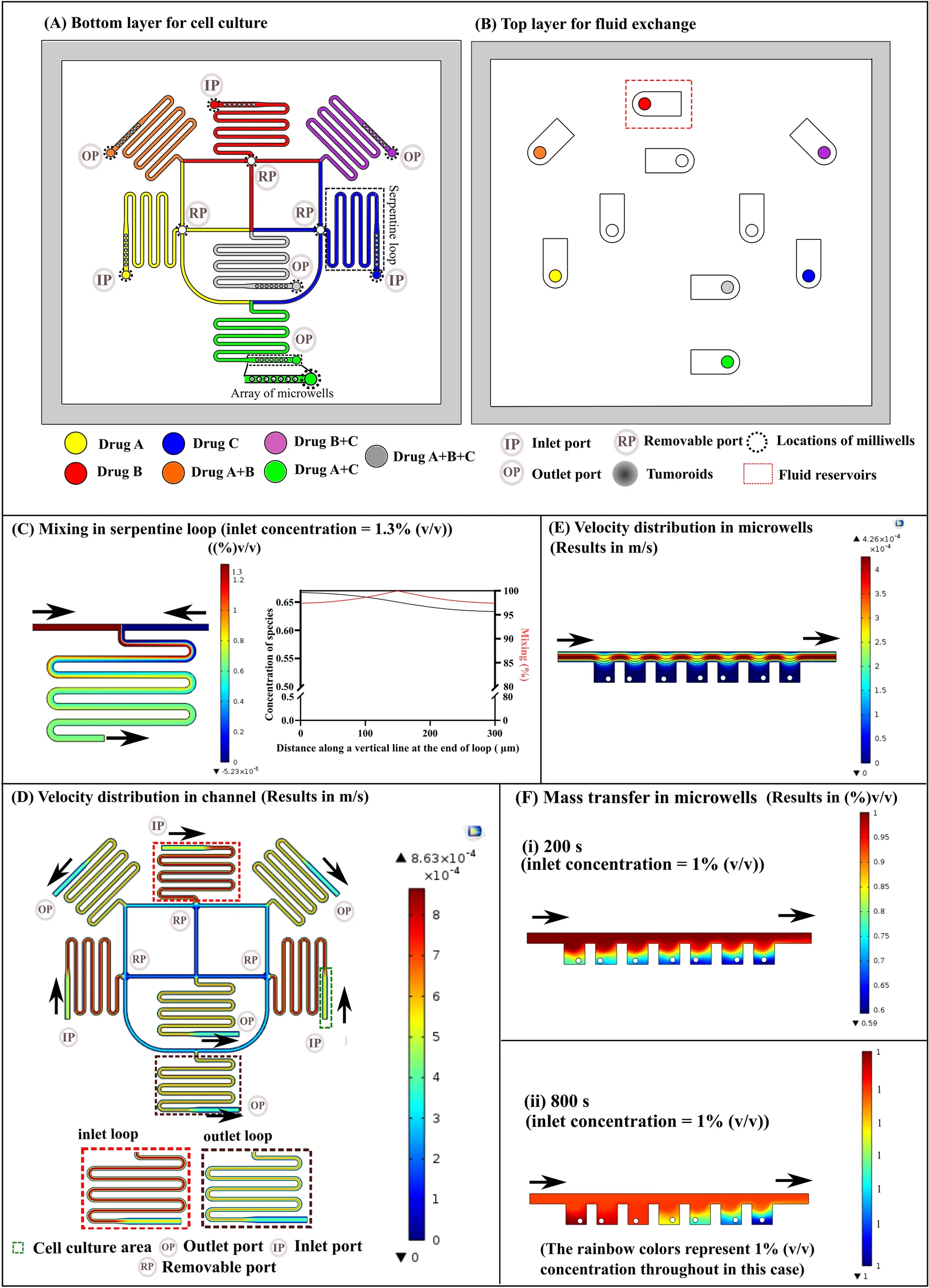
一种可重构的微流控细胞培养系统,该系统通过堆叠包含预处理微环境的层来促进3D组织模型的组装。
Introduction
单核吞噬细胞(单核细胞)和它们的后代——巨噬细胞在决定肿瘤进程中有种重要功能。作为免疫系统的中央调节器,巨噬细胞负责识别和引导消除致病源和病原细胞,比如在肿瘤中发现的那些。然而在很多情况下,肿瘤重新把常驻巨噬细胞和募集的单核细胞再教育为肿瘤相关巨噬细胞(tumour-associated macrophages, TAMs),限制了免疫监督的有效性。TAMs抑制炎症免疫反应,通过促进血管生成促进肿瘤生长,甚至刺激肿瘤分化(如前列腺癌成为非激素依赖性肿瘤)。因此,尽管经典活化的巨噬细胞具有抗肿瘤特征,但在临床研究中巨噬细胞浸润肿瘤往往与预后不良相关。虽然临床报告证明了靶向肿瘤与单核细胞相互作用的潜在用途,但由于缺乏良好的生物学模型,研究这些相互作用一直很困难。
在癌症中,M1极化巨噬细胞和M2极化巨噬细胞分别指促炎(即肿瘤根除)和促进肿瘤的巨噬细胞表型,尽管人们普遍认为巨噬细胞存在一个连续的极化状态。为了更好的理解和靶向TAMs,我们需要一个可以在生物学相关顺序和时间条件上操纵每个部分(也就是上皮、细胞外基质(ECM)、血管生成组织、单核细胞和巨噬细胞)的模型。能够培养两种或两种以上不同细胞类型(即共培养和多培养)的体外平台对我们理解细胞信号传导有重要贡献,并为研究复杂的癌症-炎症相互作用和癌症进展提供了基础。
这里作者提出了一个堆叠的多培养系统——Stacks,可以允许人们建立多培养环境的子集并且控制这些子集的时间和空间交互。可以在实验流程的进程中堆叠、取消堆叠和动态重配置各层而不中断培养。因此研究者被授权通过简单的将各层连接在一起的行为来决定复杂性增加和细胞间通讯开始的时间。
巨噬细胞的M1/M2型极化:
巨噬细胞按照其表型和分泌的细胞因子可以分为两种计划类型,即经典活化(Classically activated)的M1型和选择性活化(Alternatively activated)的M2型巨噬细胞。
以分泌促炎因子为主,发挥促炎功能的巨噬细胞称为M1型巨噬细胞。
以发挥降低炎症反应,发挥组织修复功能为主的巨噬细胞称为M2型巨噬细胞。
Fig. 1 | Schematic and concept of Stacks, a reconfigurable multilayer suspended microfluidic system

- (a)微环境能被准备在单个层的示例。
- (b)层可以使用固定器(蓝色),以堆叠的方式被垂直组装。
- (c, d)层可以拆卸成像和终点测量。对堆栈中取出包含内皮细胞和成纤维细胞混合培养物的底层,然后进行内皮标记CD31(绿色)和DAPI染色(蓝色)的免疫细胞染色以可视化内皮结构。
- (c)混合培养的内皮细胞和成纤维细胞在底层形成了血管状结构网络,没有细胞的培养基被添加到顶层作为控制组。
- (d)顶层有巨噬细胞和底层有内皮-成纤维细胞混合物的多培养导致了内皮细胞实质性的不同形态,相比于没有巨噬细胞的混合培养。
PMA相关,该博文亦有涉及。
Fig. 2 | Principles of suspended microfluidics enable layers to be stacked without bonding and without leaking outside the channels

- (a)悬浮的微流控通道可能通过将各层叠加形成堆栈来连接。堆叠的两个悬浮微流控通道创造了一个间隙(高度为W1),液体会在这之间产生毛细现象。毛细流的出现通常导致堆栈失败。
- (b)固定设计(T型截面)提供了额外的液体固定力,在堆栈设计中提供了更大的灵活性,增加了堆栈中流体稳定性。
- (c)基于表面张力的拉普拉斯压力允许建立虚拟壁,防止液体在堆栈间泄漏。
- (d)不同类型的可以用于堆栈层的培养孔的示意图:悬浮培养孔(顶层),有实体底或渗透膜的培养孔(中层),有有限孔/洞的培养孔(底层)。绿色阴影显示培养区域。
- (e)除了培养孔,开放的微流控通道可以被整合到每层以能够在整个堆栈组中处理流体。不同的通道设计被提出:一个流通的通道灌注培养孔(顶部),一个流体旁路层允许流体在各层流通而不与培养孔相互影响(中层),一个扩散交换通道可以添加小的侧通道以通过流体连接培养孔(底层)。
- (f)三层主流道填充有黄色液体,培养孔有绿色液体的堆栈系统照片。
- (g)流体可以用在含不同设计的通道和孔的层。出口孔(位于顶层右边和底层左边)连接下一场的入口使用特别设计的突出特征。第一步里的带红边的黄色梯形代表移液枪头。
Transwell:科普。
Fig. 3 | Reconfigurable Stacks system enables addition and removal of macrophages at different stages to study chronological effects in cell signalling

- (a)堆叠流程的示意图。在条件1,内皮细胞(HUVECs)和成纤维细胞(nHDFs)的2D混合培养在体外形成了一个血管样结构的网络。在条件2和3,单独准备的巨噬细胞立即或接种1天后,堆叠在混合的内皮-成纤维细胞培养物上。在条件4,从堆栈上移除巨噬细胞层导致CD31和核染色的丢失。
- (b-d)3次独立实验的6个通道的混合的内皮-成纤维细胞培养物的荧光显微镜图像。其中绿色为CD31,蓝色为DAPI。
- (b)条件1,第6天。
- (c)条件2,第6天。
- (d)条件3,第6天。
- (e-g)对于条件1、2和3,节点数、总DAPI计数和平均分支长度的量化。
- 增加巨噬细胞导致了平均分支长度增加。
- 在稍晚的时间点添加巨噬细胞导致的形态改变介于立即添加和无巨噬细胞之间。
- 在稍晚的时间点添加巨噬细胞导致核和血管网络的显著减少。
- 通过移除巨噬细胞关闭交流,导致了CD31和核的信号显著降低。
- (h-i)同b-d,3次独立实验的6个通道的混合的内皮-成纤维细胞培养物的荧光显微镜图像。
- 可以看到DAPI和CD31信号减少的连续过程。
- (j)MDC染色提示在条件4去除巨噬细胞后12h自噬明显增加;与条件3相比,条件4中的细胞具有更多的自噬行为。
自噬(autophagy)是细胞受到刺激后吞噬自身的细胞质或细胞器,最终将吞食物在溶酶体内降解的过程,自噬体(autophagosome)为双层膜包被的圆形或椭圆形结构,内含细胞质、长寿蛋白质和异常蛋白聚集物,损伤或多余细胞器如线粒体、粗面内质网和微体、病毒和细菌等。丹磺胺(Dansylcadaverine,MDC)是一种荧光色素,是嗜酸性染色剂,通常被用于检测自噬体形成的特异性标记染色剂,其检测激发滤光片波长355nm。阻断滤光片波长512nm。
Fig. 4 | A sequential Stacks assay was performed to achieve organotypic differentiation of TAms in 2D culture

最初,od-TAMs是通过与雄激素敏感型(LNCaP)或雄激素非依赖性(C4-2)前列腺癌细胞系进行体外分层共培养而分化的;然后使用2D血管生成试验来检测od-TAMs对血管生成的影响。
- (a)堆栈流程的示意图。前列腺癌细胞系(LNCaP或C4-2)被培养汇集到单层,用PMA处理的THP-1单核细胞(第一步),制备一个活化的单核细胞(M0)分离层。M0层和前列腺癌细胞层在分离前被堆叠3天(第二步)。去除前列腺癌细胞系后,巨噬细胞静置3天以成熟(第三步)。成熟的巨噬细胞与2D血管生成试验层叠层培养。将包含巨噬细胞和成纤维细胞-内皮细胞层的堆栈培养3天,分别固定每层,对成纤维细胞-内皮细胞层进行免疫细胞化学实验。
- (b-e)比较相关mRNA表达水平。b-c为M1极化相关mRNA,与促炎相关;d-e为M2极化相关。
- (b)CXCL10在与LNCaP-AM层或C4-2-AM层堆叠分化的TAMs中的表达。
- (c)CXCL11在与LNCaP-AM层或C4-2-AM层堆叠分化的TAMs中的表达。
- (d)IL10在与LNCaP-AM层或C4-2-AM层堆叠分化的TAMs中的表达。
- (e)MRC1在与LNCaP-AM层或C4-2-AM层堆叠分化的TAMs中的表达。
- (f-g)与LNCaP-AM层或C4-2-AM层堆叠培养的成纤维细胞-内皮细胞层形成的血管样网络结构。
- (f)与LNCaP-AM层堆叠培养的成纤维细胞-内皮细胞层形成的血管样网络结构。
- (g)与C4-2-AM层堆叠培养的成纤维细胞-内皮细胞层形成的血管样网络结构。
Fig. 5 | A sequential Stacks assay was performed to achieve organotypic differentiation of TAms in 3D culture

与Fig. 4平行的使用3D培养方法的试验。
- (a)堆栈流程的示意图。LNCaP和C4-2前列腺癌细胞系被培养在夹在培养基层(粉色)中间的3D基质胶层(黄色)。随后包含悬浮在培养基的THP-1单核细胞层(蓝色)堆叠在胶原蛋白基质层(绿色)和准备好的前列腺癌细胞3D培养层(黄色)上面。堆栈培养3天,来自前列腺癌细胞的溶解的因子使一些单核细胞粘附和侵入基质。3天后,移除前列腺癌(黄色)和独立的THP-1单核细胞(蓝色),巨噬细胞层(绿色)在两层新鲜的培养基(粉色)中继续静置3天。成熟的巨噬细胞(绿色)在3D HUVEC血管生成层堆叠培养。血管生成层被多聚甲醛(PFA)固定在基质,荧光染色F-actin和DAPI。
- (b-e)比较相关mRNA表达水平。
- (b)CXCL10在与LNCaP-AM层或C4-2-AM层堆叠分化的TAMs中的表达。
- (c)CXCL11在与LNCaP-AM层或C4-2-AM层堆叠分化的TAMs中的表达。
- (d)IL10在与LNCaP-AM层或C4-2-AM层堆叠分化的TAMs中的表达。
- (e)MRC1在与LNCaP-AM层或C4-2-AM层堆叠分化的TAMs中的表达。
- (f-g)3D培养下的LNCaP(f)和C4-2(g)活化的巨噬细胞的血管网络形成。与C4-2活化的巨噬细胞形成的网状结构相比,显示出更细更小的血管。
- (h)LNCaP-AMs培养的微血管的平均分支长度明显短于C4-2-AMs培养的微血管。
F-actin相当于聚合形式,β-actin相当于单体。
鬼笔环肽: phalloidin, 一种微丝骨架的稳定剂。
Fig. 6 | Selected transcriptional profile of od-TAms generated from culture with primary prostate cancer punch-biopsy samples

数字表示od-TAMs中CXCL11(a)、CXCL10(b)、IL10(c)和MMP9(d) mRNA表达与对照组(THP-1单核细胞堆叠层培养)表达的倍数变化,并归一化为参考基因P0(又称RPLP0)。
反应了od-TAMs转录组的异质性。其中T为肿瘤、B为良性。
Outlook
细胞调节在疾病发病机制和器官类型模型发展中的重要性正变得越来越明显。然而,在传统的培养系统中,探测和操纵多种细胞类型之间的时间通讯,同时提供对微环境的控制是一项挑战。
通过作者的Stacks模型,显示了巨噬细胞在体外促进血管生成能力中时间的重要性,并再现了体内观察结果,即不同时间巨噬细胞的招募和缺失显著影响肿瘤组织重塑。也能灵敏地揭示出由密切相关的肿瘤模型而分化的单核细胞之间的细微差别(例如,在LNCaP细胞与C4-2细胞相比,巨噬细胞中CXCL10和CXCL11表达显着增加),从而提高了研究肿瘤与巨噬细胞相互作用中的异质性反应的分辨率。
Reference
Yu J, Berthier E, Craig A, et al. Reconfigurable open microfluidics for studying the spatiotemporal dynamics of paracrine signalling[J]. Nature Biomedical Engineering, 2019, 3(10): 830–841.



